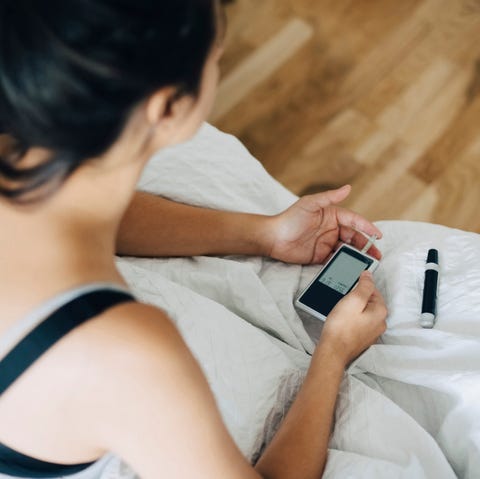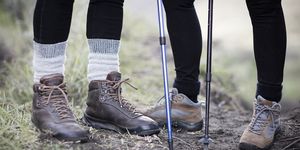
Here’s a scary stat: More than 30 million people in the U.S. have diabetes, according to the Centers for Disease Control and Prevention (CDC)—and 25 percent don’t even know they have it.
But it gets worse: 84 million more Americans have pre-diabetes (a.k.a., almost diabetes, when your blood sugar levels are high, but not high enough for full-blown diabetes)—and 90 percent of those people don’t know they have it either, per the CDC.
Back up—remind me what diabetes is again.
Diabetes isn’t just one disease. There are actually three types of diabetes: type 1, type 2, and gestational diabetes. Most people with diabetes have type 2—it happens when your body doesn’t use insulin well and is unable to keep your blood sugar stable, per the CDC.
Type 1 diabetes is much less common—only about 5 percent of those with diabetes have type 1—and it’s essentially an autoimmune disease where your body stops making insulin at all (and as such, can’t regulate blood sugar).
And gestational diabetes occurs in pregnant women—it usually goes away after you give birth, but it can increase your likelihood of developing type 2 diabetes later on, according to the National Institute of Diabetes and Digestive and Kidney Diseases (NIDDK).

All three types of diabetes can easily be detected though a blood test. The test, essentially, checks to see if your blood glucose (a.k.a. blood sugar) is too high. But be warned: You can’t diagnose yourself—not even with an OTC blood glucose meter, per the NIDDK.
Unfortunately, many people are walking around with undiagnosed diabetes or prediabetes because the symptoms are super-subtle, says Poorani Goundan, M.D., an endocrinologist at Boston Medical Center.
These sneaky diabetes symptoms might indicate that it’s time to head into your doctor’s office for a test.
1. You have to pee all the time.
When you have excess sugar coursing through your blood stream, your body instinctively tries to get rid of it, says Mary Vouyiouklis Kellis, M.D., an endocrinologist at Cleveland Clinic. “Water follows sugar, so you end up having high-volume urine loss,” she explains.

If you notice you’re suddenly peeing a lot, and more often, for no real reason—especially if you’re waking up a few times during the night to go—it’s time to talk to your doctor, she says.
2. You never stop drinking water.
With all that peeing, dehydration is a very real possibility. And, to make matters worse, “some patients who don’t know they have diabetes quench their thirst with sugary drinks like soda or juice, which adds to their blood sugars,” Goundan says. Signs of dehydration include dark-colored urine, a drop in (water) weight, and extreme thirst.
Sound familiar? Talk to your doc about this potential symptom of diabetes, especially if it occurs in tandem with lots of bathroom breaks.
3. Your breath smells awful.
Diabetes-related dehydration contributes to dry mouth, and the bad breath that can accompany it. (After all, with dry mouth, there’s not enough spit to wash away bacteria and balance the pH in your mouth, Kellis says.)

What’s more, undiagnosed or uncontrolled diabetes can trigger ketosis, a process in which the body uses fat, rather than glucose, for energy. Ketosis releases a chemical byproduct called ketones, which can make your breath smell unpleasantly sweet or fruity, she says—sometimes it might even smell like acetone, since that’s a type of ketone.
Unless you’re on a keto diet (which is designed to put you into ketosis), it’s worth talking to your doctor.
4. Your vision’s getting increasingly blurry.
Blurry vision is a common—and often ignored—diabetes symptom in women. What does diabetes have to do with your vision? Kellis explains that fluid can form in your eye’s lens as sugar levels increase (remember: fluid follows sugar).
Diabetes can cause significant, unexplained weight loss. Think: 10 or 20 pounds.
A buildup of fluid in the eye blurs vision, causes nearsightedness, and sends many people to the optometrist for a new glasses or contacts prescription.
Fortunately, getting your blood sugar levels under control can clear up blurred vision, she adds.
5. Your hands and feet fall asleep a lot.
Neuropathy—a condition characterized by numbness or weird sensations like pins and needles in your arms, legs, hands, and feet—occurs in more than half of people with type 2 diabetes, according to a 2017 Diabetes Care review.
Why so common? Diabetes reduces blood flow to your extremities and, over time, damages your blood vessels and nerves, Kellis says.
6. Your cuts and bruises take forever to heal.
Reduced sensation in your extremities makes you more prone to injuries. “You’re less likely to notice a cut because you can’t feel it, which means you’re less likely to take care of it and it’s more likely to get infected,” says Goundan.

Then, once you do have an injury, uncontrolled diabetes can make it harder for your body to heal. “High blood sugars provide a good environment for bacteria to grow,” she says. That’s because diabetes is also often accompanied by high blood pressure and high cholesterol, and the resulting plaque buildup can narrow blood vessels, reducing blood supply and leading to slow healing.
Diabetes can also weaken the T-cells that make up your immune system—your body’s defense against infection. “When you have high blood sugar, it’s like delaying your body’s army to go to the wound to heal it,” says Kellis.
7. You’re losing weight…but aren’t trying to.
Unexplained weight loss can happen for lots of reasons, and diabetes is one of them. Goundan explains that insulin helps your body move sugar from your blood to your cells, so when you have an insulin resistance, you don’t get enough energy into your cells despite all that sugar flowing through your body. “Because you’re unable to get enough energy from sugar, your body burns your own fat and muscle for energy,” Kellis says. “Weight loss can be pretty significant, sometimes 10 to 20 pounds.”
Generally, doctors recommend visiting the doc if you unintentionally lose between 5 to 10 percent of your body weight over the course of six months.
8. You get enough sleep, but you’re still so tired.
Carbohydrates, which your body breaks down into glucose, are your body’s main source of energy. But your body can’t effectively use that source of energy when you have diabetes, explains Goundan. (And diabetes-related dehydration can also bring on fatigue.)

Of course, there are tons of other reasons you could be feeling exhausted, including your diet, stress levels, and how much you’ve been sleeping.
Still, if you can’t think of any other good reason for your extreme fatigue, and your low energy levels are accompanied by some of these other diabetes symptoms, it’s worth getting checked out.
9. You get a surprising number of yeast infections.
High blood sugars create an environment in your vagina that’s ripe for yeast infections. “Glucose is fuel for yeast. The more that’s around, the more they can multiply,” says Kellis.
If you’re having two to three yeast infections every few months or if the standard treatments just aren’t working, it’s time to see a doctor. “Once blood sugar is controlled, the frequency goes down,” says Goundan.
10. You’ve got weird dark spots on your skin.
Darkening skin around the nape of your neck, under your armpits, or even in your groin area is a surprising and common early sign of insulin resistance, the precursor to diabetes—the medical name for the condition is acanthosis nigricans (AN).
“We see this often in women with polycystic ovary syndrome (PCOS),” says Kellis, who notes that women with PCOS are at an increased risk of insulin issues. If you notice new dark spots on your skin, they’re worth checking out with your doctor.
11. You feel really itchy all the time.
Those with diabtetes often experience itching due to yeast infections (which can occur on the skin, too), dry skin, or poor circulation, according to the American Diabetes Association. If poor circulation is to blame, your legs will be the itchiest area.
Per the ADA, you can try to treat the itching yourself by limiting how much you bathe (especially in less humid climates), using soap with a built-in moisturizer, and remembering to apply lotion immediately after washing up.
Source: Read Full Article
